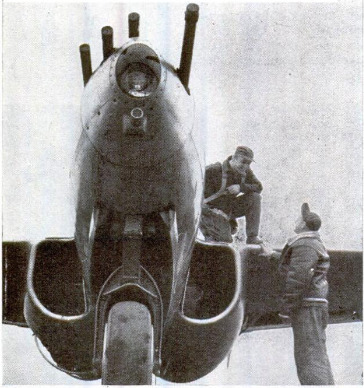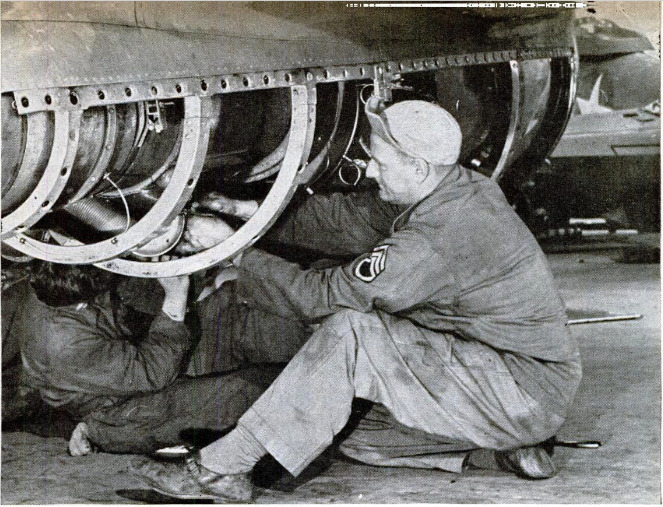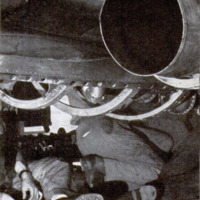-
Titolo
-
The plane of tomorrow smells like an oil stove
-
Article Title and/or Image Caption
-
The plane of tomorrow smells like an oil stove
-
extracted text
-
THE P-51 mechanic, curiosity and
perhaps a trace of contempt
written on his features, squatted
under the wing of the jet-propelled
plane and ran an eye over the flame
tube. Other mechanics were in-
stalling an engine in the jet job.
S/Sgt. Earl Kohler, in charge
of the project, glanced up.
“How does she look, Bill?” he
asked the Mustang man.
“Well,” came the considered re-
ply, “I'd call that a plumber’s
nightmare.”
That was early in the history of
jet propulsion in the Army Air
Forces. Since that day, mechanics
on conventional fighters and bomb-
ers have asked Kohler and his crew
a million questions about servicing
the jet plane.
“They want to know,” says Ser-
geant Kohler with some impatience,
“what wrenches we use. How long
it takes to pull an engine. How the
jet works. One guy even asked if
it uses fuel. All kinds of damn fool
questions.” }
Kohler, who operated a garage
for 15 years before he went into
the Army, was one of the first AAF me-
chanics chosen to work on the original
XP-59A jet plane while it was being put
through months of tests in the California
desert. After the project was revealed, he
‘was sent to Wright Field to keep the planes in
shape for training and further experiments.
“Every mechanic gets a funny feeling
‘when he first sees the jet job,” Kohler says.
“I remember what I thought. I said to
myself, ‘Hell, this thing won't fly. There's
not enough stuff.” But after the jet took off
a few times, I began to get the idea.”
Mechanics trained on Thunderbolts, Light-
nings, Marauders, and Fortresses—any of
our aircraft with conventional engines—
have learned to think of power in terms
of solid machinery, Kohler explains. In a
conventional engine everything is solid and
tight. Mechanics think in terms of com-
plicated wiring, ignition, gauges and cylin-
ders, elaborate fuel systems. Everything is
complicated.
“But in the jet plane everything is simple,”
Kohler says. “You put in six quarts of oil,
just like an automobile.”
The cooling system is just a couple of
oil jets which spray lubricant and air into
the two rotor shaft bearings. The oil is
standard hydraulic fluid 3580. The excess
runs down and forward into the accessory
section, and is returned by a small scavenge
pump. The system is cleaned by a Cuno
filter. The generator, fuel pump, and starter
are the only accessories carried over from
the conventional plane, and the ignition is
even more simple than the oil system.
There are only two spark plugs, located in
the No. 4 and No. 8 combustion chambers.
The other chambers are interconnected
and ignite from these two. After the unit
is started, combustion continues without
further assistance from the plugs. Com-
bustion is as steady as the flame of an oil
furnace. Plugs last as long in the intense
heat of the jet as they do in a conventional
engine. In the jet their spark gap is con-
siderably wider.
Kohler and his men work on the P-50A,
which must be classed as a training plane
in the jet field. Yet, with few exceptions,
their experiences would be applicable to any
jet aircraft.
“We use about a fifth as many tools,”
Kohler explains, “and maintenance of a
jejt plane is less than a fifth of what it is
on the other kind. As for the engine, it’s
so damn simple I can't understand it.
“Air comes in the front end, goes through
the compressors,
mixes with kerosene in the combustion
chambers, and is ignited. It blasts out
through the flame pipe, and that’s all there
is to it. How the hell that makes an air-
plane fly, I don’t know.”
Engineers, explaining the jet force which
drives a plane, have compared it to the
strong, sudden whip at the nozzle of a
garden hose when water is turned on full
force.
“Most mechanics are surprised to learn
that there are only eleven bolts holding the
engine in place,” the sergeant comments.
“And not very big bolts at that. In the
engine there are but two main bearings and
one shaft.
“I can pull an engine with an inexperi-
enced crew in 35 minutes, and four men can
pull both engines and install new ones in a
day. Where we used to spend five days
doing a certain job on a conventional plane,
we can do the same thing for a jet in a day.
Where other mechanics would use 25
wrenches for a certain type of job, we
generally use about five.”
All the equipment necessary for changing
a jet engine can be carried in the plane,
and this consists of a small wing holst and
frame, and a cradle to support the engine
when removed. Since the unit is so close to
the ground, no work stands are necessary
to reach any part of it.
Mechanics invariably ask about the jet
exhaust and want to know how close a
person can stand in front or behind the
engines, Kohler says. Most of them have
heard fanciful stories about women hav-
ing their dresses whisked off by the suction
of air going nto the engines. And there is
one story, widely told, of an officer who
tried to look into the rear end and got his
cap visor scorched off back to the eagle.
Kohler does not believe these tales, but he
does know a guy who stepped into the ex-
haust and was Kicked back 70 feet in fast
somersaults.
“Td say a person should keep at least
200 feet behind a jet engine when it is
blasting,” the sergeant recommends. “You
can stand closer without getting hurt.”
Once a flight is over, mechanics don’t
need to let the plane cool oft before begin-
ning work on the engine. By the time they
get the cowling off, the engine is cool
enough to be taken out.
Development of the AAF jet plane, one
of the best-kspt secrets of the war, took
place at Muroc, Calif, where Kohler said
he signed away his life every day. “Every
time turned around I was signing some-
thing, promising that I would keep. my
mouth shut.”
Even the commanding officers at an AAF
base near by did not know what was going
on inside the restricted area of the desert.
Pilots were forbidden to fly over it and no
amount of rank could get a curious officer
into the field. On several occasions, the fet
plane was seen smoking through the sky
and frantic telephone calls came from the
neighboring air base notifying jet crews
that a burning plane had fallen on their
field. The callers were politely thanked for
their concern.
One afternoon, when the experimental
plane was smoking heavily, the neighboring
air base called out its fire and crash equip-
ment and sent it clanging down the high-
way to the secret station. The crash wagons
pulled up at the main gate and demanded
to be let inside, drivers shouting that they
had the location of a burning plane.
Again, the guards were compelled to
thank them quietly and politely—and keep
the gates locked. On another occasion a
bird colonel became so curious that he drew
himself up to full height before the guards
and demanded to know what was going on
behind all the secrecy and mystery. A
security officer had to be called out to
pacify him.
“Colonel,” he said, “behind those hangar
walls is the hope of tomorrow. We are
coming out with a gadget that will revolu-
tionize the sewing machine.”
Perhaps the simplest function of fet
maintenance is servicing the plane with
fuel. This is no more involved than calling
the kerosene truck and filling up. The fuel
is thoroughly filtered to safeguard the
barometric fuel controls. These units do
what the regulator on a turbo-supercharger
does-—they maintain a constant power with
changing altitude. The engine can operate
on nearly any hydrocarbon fuel such as
gasoline, kerosene, alcohol, and even hair
tonic or brandy.
The jet engine has about 10 percent as
many moving parts as a reciprocating en-
gine and, since there is only a rudimentary
ignition system and no carburetor, there is
no elaborate mixture control, nor prop con-
trol, nor icing worries.
“You get all that in something they call
a plumber's nightmare,” Kohler says. “I
take them apart and put them back, and
I still can't find what makes them fly. It's
the airplane of tomorrow—and it smells like
an old ofl stove.”
-
Autore secondario
-
Edward T. Wallace (article writer)
-
Lingua
-
eng
-
Data di rilascio
-
1945-03
-
pagine
-
70-71,224,228
-
Diritti
-
Public domain
-
Archived by
-
Sami Akbiyik
-
Marco Bortolami (editor)





